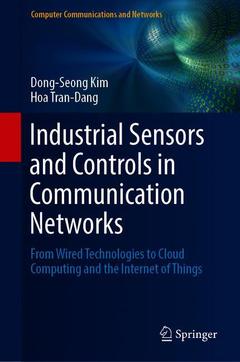Description
Industrial Sensors and Controls in Communication Networks, 1st ed. 2019
From Wired Technologies to Cloud Computing and the Internet of Things
Computer Communications and Networks Series
Authors: Kim Dong-Seong, Tran-Dang Hoa
Language: English
Subjects for Industrial Sensors and Controls in Communication Networks:
Approximative price 137.14 €
In Print (Delivery period: 15 days).
Add to cartSupport: Print on demand
Description
/li>Contents
/li>Biography
/li>Comment
/li>
This informative text/reference presents a detailed review of the state of the art in industrial sensor and control networks. The book examines a broad range of applications, along with their design objectives and technical challenges. The coverage includes fieldbus technologies, wireless communication technologies, network architectures, and resource management and optimization for industrial networks. Discussions are also provided on industrial communication standards for both wired and wireless technologies, as well as for the Industrial Internet of Things (IIoT).
Topics and features: describes the FlexRay, CAN, and Modbus fieldbus protocols for industrial control networks, as well as the MIL-STD-1553 standard; proposes a dual fieldbus approach, incorporating both CAN and ModBus fieldbus technologies, for a ship engine distributed control system; reviews a range of industrial wireless sensor network (IWSN) applications, from environmental sensing and condition monitoring, to process automation; examines the wireless networking performance, design requirements, and technical limitations of IWSN applications; presents a survey of IWSN commercial solutions and service providers, and summarizes the emerging trends in this area; discusses the latest technologies and open challenges in realizing the vision of the IIoT, highlighting various applications of the IIoT in industrial domains; introduces a logistics paradigm for adopting IIoT technology on the Physical Internet.This unique work will be of great value to all researchers involved in industrial sensor and control networks, wireless networking, and the Internet of Things.
Part I: Industrial Control Networks
An Overview of Industrial Control Networks
FlexRay Protocol: Objectives and Features
Communication Using CAN Protocol
Distributed Control System for Ship Engines Using Dual Field-Bus
Implementing Modbus and CAN Bus Protocol Conversion Interface
MIL-STD-1553 Protocol in High Data Rate Applications
Research and Design of 1553B Protocol Bus Control Unit
Part II: Industrial Wireless Sensor Networks
An Overview of Wireless Sensor Networks
Wireless Fieldbus for Industrial Networks
Wireless Sensor Networks for Industrial ApplicationsA Survey of MAC Protocols for Energy-Efficient Wireless Sensor Networks
Cooperative Multi-Channel Access for Industrial Wireless Networks Based on the 802.11 Standard
802.11 Medium Access Control DCF and PCF: Performance Comparison
An Overview of Ultra-Wideband Technology and its Applications
Ultra-Wideband Technology for the Military
Part III: Industrial Internet of Things
An Overview of Industrial Internet of Things
Energy-Aware Real-Time Routing for Large-Scale Industrial Internet of Things
A 3D Perception Framework for Stacked Containers on the Physical Internet
An Information Framework for Internet of Things Services on the Physical InternetProf. Dong-Seong Kim is Director of the KIT Convergence Research Institute and ICT Convergence Research Center (ITRC program), supported by the Korean government, at Kumoh National Institute of Technology, Gumi, South Korea. He is a senior member of the IEEE and ACM.
Dr. Hoa Tran-Dang is a research professor, working in the NSL Laboratory, in the Department of ICT Convergence Engineering at Kumoh National Institute of Technology.
Presents a detailed review of industrial sensor and control network applications and technologies
Describes technical challenges and design objectives, covering fieldbus technologies, wireless communication technologies, network architectures, and resource management and optimization for industrial networks
Reviews industrial communication standards, including those for wired and wireless technologies, and the Internet of Things




